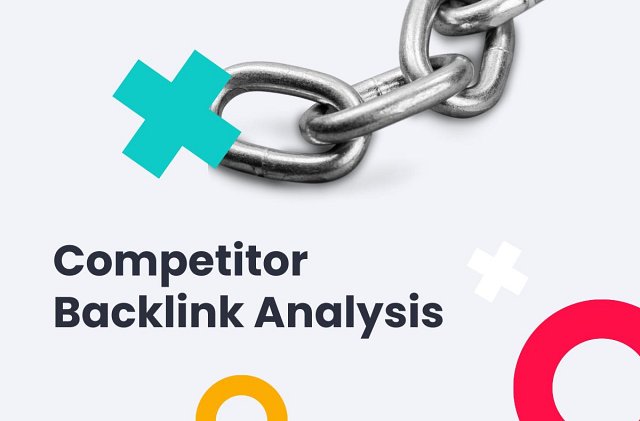(12 min. read)

Table of Contents
- What is Competitor Backlink Analysis?
- Why Conduct a Competitor Backlink Analysis?
- Tools for Competitor Backlink Analysis
- How to Perform a Competitor Backlink Analysis:
- Building a Winning Link Building Strategy Based on Your Analysis
- Common Pitfalls and How to Avoid Them
- Conclusion
What is Competitor Backlink Analysis?
Competitor backlink analysis is a fundamental SEO tactic that involves carefully examining the backlinks of your competitors’ websites. This process helps you see what types of websites are linking back to your competitors, understand the quality and relevance of those links, and identify opportunities to improve your own backlink profile. By analyzing the backlinks of websites that rank well for keywords relevant to your business, you can gain valuable insights into which link-building practices are likely to contribute to high rankings.
Search engines like Google use backlinks as a key metric for determining a website’s credibility and authority, which significantly contribute to positioning. Websites with a high number of quality backlinks tend to rank higher in search engine results pages (SERPs), making backlinks a critical factor for SEO success.
Competitor backlink analysis provides several benefits, including the ability to:
- Identify high-quality link-building opportunities — By understanding where your competitors are getting their backlinks, you can target similar sources to build your own backlinks, potentially improving your website's authority and search engine rankings.
- Reveal gaps in your own backlink strategy — Analyzing your competitors' backlinks can help you identify areas where your own backlink profile may be lacking, allowing you to adjust your SEO strategy as necessary.
- Benchmark against the competition — It’s a benchmark you can use to measure the strength and quality of your backlink profile against that of your competitors, helping you to understand where you stand in the competitive landscape.
- Spot trends in your industry — Competitor backlink analysis can also reveal broader trends in your industry, such as emerging websites or influential bloggers, which can inform your broader marketing and outreach strategies.
Why Conduct a Competitor Backlink Analysis?
Knowing what are your strengths and what are your weaknesses is only half the battle. The other half lies in understanding the landscape in which you operate. Performing a competitor backlink analysis is a proactive strategy that can significantly improve your SEO performance, with numerous advantages behind it.
One of the most compelling reasons to analyze your competitors’ backlinks is to discover new backlink opportunities for yourself. By examining the sources of your competitors’ links, you can identify websites that are likely to be receptive to linking to your content as well.
Keeping track of where you stand relative to your competitors is crucial for setting realistic SEO goals and strategies. Analyzing the backlink profiles of top-ranking competitors can help you gauge the volume and quality of backlinks you should aim for to surpass them in search engine rankings.
Competitor backlink analysis can also shed light on the types of content that are earning backlinks in your industry. Whether it's comprehensive guides, case studies, or infographics, understanding the content formats that are the most popular with your audience can strengthen your own content strategy and help you produce link-worthy material.
Uncovering Link Building Opportunities
Through competitor backlink analysis, you gain access to a roadmap of potential avenues for securing backlinks that can boost your site's authority and search engine ranking. This process goes beyond merely identifying where your competitors are getting their links from; it involves a deep dive into the context, quality, and relevance of these links to understand how they can be leveraged for your benefit.
Often, several competitors might share common backlink sources. These sources represent low-hanging fruits in your link-building efforts. By identifying these commonalities, you can prioritize these sources for your outreach, as they are likely to be more receptive to linking to similar content in your niche.
Look for patterns in the content that is being linked to. Are there topics or types of content (like tutorials, infographics, research papers) that are consistently earning backlinks? Identifying these gaps or popular formats in your own content strategy can guide you to produce content that fills these voids, increasing your chances of earning backlinks.
During your analysis, you may find broken links (links that no longer lead to active pages) in your competitors' profiles. These present unique opportunities for you to reach out to these websites and suggest your content as a replacement for the broken link, providing a valuable service to the site owner while securing a backlink for yourself.
Benchmarking Against Competitors
Benchmarking against competitors involves a comprehensive comparison of your backlink profile against those of your key competitors, focusing on various metrics such as quantity, quality, diversity of links, and the rate at which new links are acquired.
Start by comparing the sheer number of backlinks and referring domains between your website and your competitors'. This gives you a baseline understanding of the gap or lead you have in terms of link quantity. Remember, more isn't always better; the quality of links plays a crucial role as well.
Evaluate the quality of backlinks by examining the authority of the referring domains. Analyze the diversity of your competitors' backlink profiles, including the variety of domains linking to them and the types of links (editorial, forums, directories, etc.). A diverse backlink profile suggests a robust and natural link-building strategy. Assessing this can help you identify areas where your link-building efforts may be too focused or not focused enough.
Tools for Competitor Backlink Analysis
Manually searching for and analyzing competitor backlinks would take ages — thankfully, there are tools that can significantly save you time and provide deep insights into the quality and quantity of backlinks.
Ahrefs is widely recognized as one of the most powerful tools for backlink analysis. It offers an extensive database of live backlinks, updated with fresh data every 15 minutes. Features like the Site Explorer allow users to examine the backlink profile of any website, revealing valuable insights such as the domain rating, the total number of backlinks, and referring domains. Ahrefs also enables users to delve into the specifics of each backlink, including anchor text and the backlink’s context.
SEMrush is another comprehensive digital marketing tool that offers robust features for competitor backlink analysis. Its Backlink Analytics tool provides detailed information about a competitor’s backlink profile, including the authority score of referring domains and the geographic distribution of backlinks. SEMrush also features a Backlink Gap tool that helps identify backlink opportunities by comparing the backlink profiles of up to five competitors simultaneously.
Moz Pro’s Link Explorer is a sophisticated tool that offers extensive capabilities for exploring the backlink profile of any website. It provides metrics like Domain Authority (DA) and Page Authority (PA), which are valuable for assessing the quality of backlinks. Users can also explore inbound links, linking domains, and the top pages by links. Moz's Spam Score metric helps to identify potentially harmful backlinks that could negatively impact SEO performance.
How to Perform a Competitor Backlink Analysis:
Step 1: Identify Your Competitors
- Direct vs. SERP Competitors: Understand the difference between direct business competitors and SERP competitors. SERP competitors are those ranking for the keywords you're targeting, regardless of their business model.
- Use SEO Tools: Utilize SEO tools like SEMrush or Ahrefs to identify competitors based on shared keywords and rankings.
- Select a Mix: Choose a mix of direct and SERP competitors for a comprehensive analysis. Focus on those in similar or slightly higher ranking positions.
Step 2: Extract and Analyze Backlink Data
- Use Backlink Analysis Tools: Employ tools such as Ahrefs, SEMrush, or Moz to gather backlink data for each competitor. These tools provide extensive insights into backlink profiles.
- Export the Data: Export backlink data to spreadsheets for in-depth analysis. Include metrics such as domain rating, page authority, link type, and anchor text.
- Assess Link Quality: Focus on the quality of backlinks by evaluating the authority of the linking domains. High-quality links from reputable sources have more SEO value.
- Understand Link Diversity: Examine the diversity in the types of backlinks (e.g., editorial, forums, blogs) and the variety of domains linking to your competitors.
- Identify High-Value Links: Look for patterns in high-value links. These could be from industry publications, authoritative blogs, or educational institutions.
Step 3: Identify Link Gap Opportunities
- Spot Common Backlink Sources: Identify sources that link to multiple competitors. These are potentially receptive sites for your link-building efforts.
- Find Content Gaps: Look for content types or topics that have earned backlinks for competitors but are missing from your site.
- Leverage Broken Links: Use tools to find broken links within competitor backlinks. These represent opportunities to suggest your content as a replacement.
Building a Winning Link Building Strategy Based on Your Analysis
Having conducted a thorough competitor backlink analysis, you're now equipped with valuable insights into the backlink strategies of your competitors. The next critical step is to use these insights to craft a link-building strategy that exceeds the effectiveness of your competitors.
- Target High-Value Backlink Sources: Prioritize outreach to websites that have linked to multiple competitors, as they are more likely to be receptive to your content. Focus on high-quality, authoritative sites that can significantly boost your SEO.
- Fill Content Gaps: Develop content that addresses topics or formats that are popular among your competitors but underrepresented on your site. This could be long-form articles, how-to guides, infographics, or case studies.
- Exploit Broken Links: Reach out to websites with broken links in your competitors’ backlink profiles, offering your content as a high-quality alternative. This tactic not only helps you gain a backlink but also assists the website owner by fixing a broken resource.
- Create Superior Content: Use the insights from your competitor analysis to understand what type of content attracts the most backlinks in your industry. Strive to produce content that is not only similar in type, but superior in quality and value.
- Optimize for Shareability: Make sure your content is easily shareable across social media and other platforms. Include engaging visuals, compelling headlines, and easy-to-share formats to increase its potential virality.
- Engage with Industry Influencers: Identify key influencers and thought leaders who frequently link to or share content in your niche. Engage with them on social media, comment on their posts, and consider outreach for guest blogging opportunities.
- Personalize Your Outreach: When reaching out to potential backlink sources, personalize your emails or messages. Show that you’ve engaged with their content, and explain why your resource would be valuable to their audience.
Monitoring Your Progress
After implementing your enhanced link-building strategy, monitoring progress becomes crucial to understanding its impact on your SEO performance and making informed decisions for future activities. Tracking the right metrics allows you to measure the success of your link-building efforts and adjust your strategy based on data-driven insights.
First, set up Key Performance Indicators (KPIs). Track how many links you attempted to acquire versus how many you successfully built. This metric helps gauge the effectiveness of your outreach and content strategies. Use tools like Google Analytics to monitor the amount of traffic each backlink generates. This insight is crucial, as it not only shows the value of a backlink from an SEO perspective, but also its direct contribution to bringing visitors to your site.
Monitor changes in third-party metrics such as Domain Rating (DR) by Ahrefs, Domain Authority (DA) by Moz, or other relevant metrics. Improvements in these scores are indicators of the growing strength and reputation of your site's backlink profile. Keep a detailed record of your link-building efforts, including outreach attempts, successful backlinks acquired, the type of content linked, and any particular strategy used. This documentation is invaluable for analyzing what works best in your niche and refining your strategy over time.
Tools like WhitePress's Backlink Manager offer specialized features for tracking the status and quality of backlinks over time. These tools can automate much of the monitoring process, alerting you to changes in your backlink profile, such as new links acquired or lost and fluctuations in the quality of linking sites.
Common Pitfalls and How to Avoid Them
In the pursuit of building a powerful backlink profile, even the most seasoned SEO professionals can sometimes stumble into pitfalls that hinder their progress. Recognizing these common mistakes and understanding how to avoid them is crucial for ensuring your link-building efforts are both effective and sustainable.
Prioritizing Quantity Over Quality
Pitfall: Focusing on acquiring as many backlinks as possible without considering the quality of the linking sites.
How to Avoid: Shift your focus to obtaining high-quality backlinks from authoritative and relevant sites. Use metrics like Domain Authority (DA) or Domain Rating (DR) to assess the quality of potential backlink sources.
Ignoring Link Relevance
Pitfall: Acquiring backlinks from sites that have no topical relevance to your website.
How to Avoid: Ensure that your backlink sources are contextually related to your site’s content. Links from relevant sites not only carry more SEO weight but also drive more meaningful traffic.
Using Unnatural Anchor Text
Pitfall: Over-optimizing anchor text with exact-match keywords, making it look artificial to search engines.
How to Avoid: Use a natural mix of anchor texts, including branded, generic, partial-match, and naked URLs. This diversity helps maintain the naturalness of your backlink profile.
Neglecting the User Experience
Pitfall: Focusing solely on link acquisition without considering the user experience on the linked pages.
How to Avoid: Ensure that the content linked to provides value and is relevant to the users following the backlink. Improving user engagement metrics like bounce rate and session duration can indirectly benefit your SEO.
Conclusion
This guide has walked you through the essential steps of conducting a competitor backlink analysis, from identifying competitors and analyzing their backlinks to leveraging this information to build a winning link-building strategy.
Key points to remember include the importance of prioritizing quality over quantity in your backlink efforts, the necessity of maintaining a diverse and relevant backlink profile, and the continuous need for monitoring and adapting your strategy based on performance data. Tools like Ahrefs, SEMrush, Moz Pro, and WhitePress's Backlink Manager play pivotal roles in facilitating these processes, offering the insights needed to make informed decisions and adjustments.
Let the insights from competitor backlink analysis guide your SEO strategy towards more effective link building. Embrace the iterative process of learning, implementing, monitoring, and refining your tactics to stay ahead in the competitive digital market.


